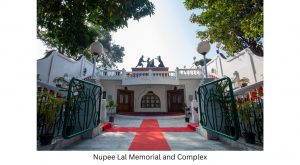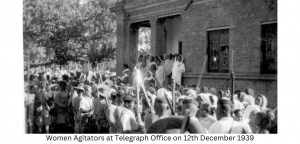Remembering the legendary Nupee Lal movements in Manipur
Remembering the legendary “Nupee Lal” movements in Manipur
For the people of Manipur, December 12 is significant because it is recognised as Nupee Lal Day (women’s war). The Nupee Lal movement is one of Manipur’s significant movements in the history of Manipur.

The movement planted the seeds for political, societal, and economic reforms in a new Manipur in the early 1940s.
Let’s take a look at the two Nupee Lal movements (1904 and 1939) that changed the course of the history of Manipur.
First Nupee Lal
The first Nupee Lal began on 15 March, 1904.
Colonel Maxwell, the state’s former Political Agent and Superintendent, tried to reintroduce the Lallup System (where men were required to perform free labour for 10 days after every 30 days).
Under the Lallup system, Manipuri men were forced to rebuild two British officers’ bungalows that had been burned down. For the reconstruction, he gave them the order to bring teak wood from Kabaw Valley. This decision backfired when the womenfolk of Imphal rose up in protest to the unfair demand for forced labour.

On September 3, tens of thousands of women spontaneously gathered and marched in the direction of Maxwell’s official residence. They were given the assurance that the order would be reconsidered, but it was all for nothing.
On October 5, more than 5,000 women then assembled at Khwairamband Bazar in protest and remained there in protest until the order was reversed.
Force had to be used to suppress the women’s protests and agitations, but in the end, the order was revoked and the British were forced to reconstruct the homes at their own expense.
The most prominent leaders of this agitation were: Smt. Irengbam Ongbi Sanajaobi Devi, Smt. Leishangthem Kwathabi Devi, Smt. Irengbam Ningol Leimapokpam Ongbi Dhabali Devi, and Smt. Laishram Ningol Juboti Devi.
Expert believed that this movement in 1904 was a significant turning point in Manipur’s history. Despite the agitation’s brief duration, it had a significant impact on the state’s political and economic landscape and laid the stage for subsequent anti-imperialist protests.
When the state authorities hiked the water tax in 1925, it was again the womenfolk of Manipur who ignited widespread protests.
Second Nupee Lal
Following the Anglo-Manipur War in 1891, Manipur was directly governed by the British until 1907, when Raja Churachand Singh and his durbar took over.
However, a political agent from the British government was hired to monitor the region’s operations and had authority over the royal durbar. This had a significant impact on Manipur’s trade and economy.
The Manipur valley was and still is a significant rice-growing region. Rice is a staple crop in Manipur. Not only the farmers in Manipur but also the women’s community relied on rice as a source of income.
Rice from Manipur was exported (primarily to Assam) even before 1891. Regardless of the output and internal demand, export volumes significantly climbed. The volume of the export of rice increased from 1,55,014 mounds to 3,72,174 mounds, even though there was an increase of only 10,322 acres of total area under cultivation from 1925-1983.
This was facilitated by the use of motorised vehicles in place of bullock carts as the primary form of transportation, which made it simpler and quicker to export huge amounts of rice.
Additionally, the British gradually turned the area into a market for imported manufactured goods, which eventually caused the local cottage industries to disappear.
The Marwari population that arrived in the area took over much of the rice trade, and Liverpool Salt, which was sold inexpensively and competed with the local brine wells.
In the meantime, when torrential rains severely affected the paddy production in July-August and November of 1939, the farmers pleaded with the durbar to forbid rice exports in order to supply local demand. The durbar temporarily agreed to lift the ban but it soon overturned under the pressure of exporters. The price of rice soared as a result of the severe shortage.
Hundreds of women protested in Imphal on December 12 calling for a ban on rice exports as well as the shutdown of rice mills because they were upset with the state of affairs. After that, they marched to the durbar’s offices.
They took TA Sharpe, the then-president of the Manipur state durbar, to the telegraph office since Maharaja Churachand Singh was in Nabadweep, and they sent the Maharaja an “urgent” telegram.

When the number of female revolutionaries reached 4,000, Assam rifles were brought to the area to disperse the gathering while Sharpe was still being held captive. This led to a significant bayonet battle and stone-throwing. There was bloodshed and many women were wounded severely.
In the aftermath, the Maharaja ordered the rice export to be ceased the following day. Hence, the rice shortage was resolved.
The second Nupee Lal’s greatest accomplishment was getting the government to agree to their demands. That was only made feasible due of the women’s cooperation, organisational skills, and intelligence. No woman was penalised for taking part in the movement.
Take Away
Since ancient times, Manipuri women have always been a vital part of Manipur’s society. The Manipuri women enjoy a unique role in the state’s social and economic activities.
Manipur’s women continue to actively take part in the state’s social reformations.
Throughout the years, Manipuri women have fearlessly led demonstrations, whether it was the Meira Paibi campaign in the 1970s against drug usage and alcoholism or the 12 women protesting the Armed Forces Special Powers Act (AFSPA) while naked in 2004.
Nupee Lal is a powerful illustration of the power of the female voice in bringing about positive social change.





